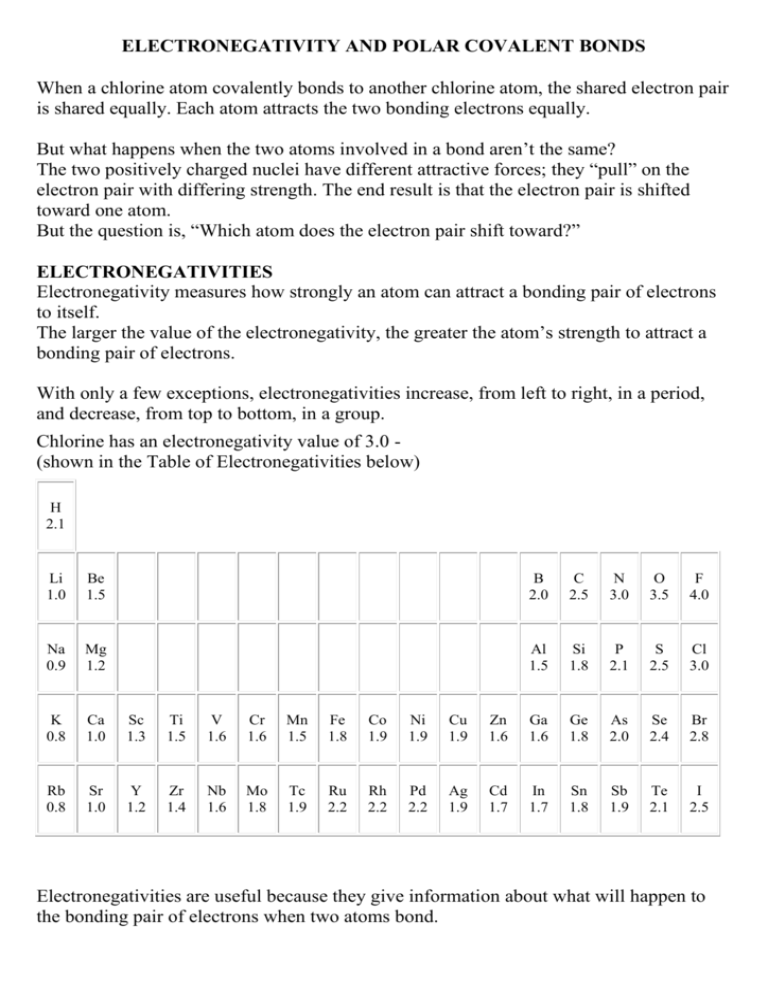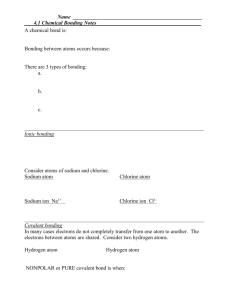electronegativity and polar covalent bonds
advertisement

ELECTRONEGATIVITY AND POLAR COVALENT BONDS When a chlorine atom covalently bonds to another chlorine atom, the shared electron pair is shared equally. Each atom attracts the two bonding electrons equally. But what happens when the two atoms involved in a bond aren’t the same? The two positively charged nuclei have different attractive forces; they “pull” on the electron pair with differing strength. The end result is that the electron pair is shifted toward one atom. But the question is, “Which atom does the electron pair shift toward?” ELECTRONEGATIVITIES Electronegativity measures how strongly an atom can attract a bonding pair of electrons to itself. The larger the value of the electronegativity, the greater the atom’s strength to attract a bonding pair of electrons. With only a few exceptions, electronegativities increase, from left to right, in a period, and decrease, from top to bottom, in a group. Chlorine has an electronegativity value of 3.0 (shown in the Table of Electronegativities below) H 2.1 Li 1.0 Be 1.5 B 2.0 C 2.5 N 3.0 O 3.5 F 4.0 Na 0.9 Mg 1.2 Al 1.5 Si 1.8 P 2.1 S 2.5 Cl 3.0 K 0.8 Ca 1.0 Sc 1.3 Ti 1.5 V 1.6 Cr 1.6 Mn 1.5 Fe 1.8 Co 1.9 Ni 1.9 Cu 1.9 Zn 1.6 Ga 1.6 Ge 1.8 As 2.0 Se 2.4 Br 2.8 Rb 0.8 Sr 1.0 Y 1.2 Zr 1.4 Nb 1.6 Mo 1.8 Tc 1.9 Ru 2.2 Rh 2.2 Pd 2.2 Ag 1.9 Cd 1.7 In 1.7 Sn 1.8 Sb 1.9 Te 2.1 I 2.5 Electronegativities are useful because they give information about what will happen to the bonding pair of electrons when two atoms bond. When two chlorine atoms join to form a chlorine molecule, each chlorine atom attracts the bonding electrons with a force of 3.0. Because there’s an equal attraction, the bonding electron pair is shared equally between the two chlorine atoms and is located halfway between the two atoms. NON-POLAR COVALENT BONDS A bond in which the electron pair is equally shared is called a nonpolar covalent bond. A nonpolar covalent bond exists whenever the two atoms involved in the bond are the same or whenever the difference in the electronegativities of the atoms involved in the bond is very small. POLAR COVALENT BONDS An example of a compound that has a polar covalent bond is hydrogen fluoride (HF). Hydrogen has an electronegativity of 2.1, and fluorine has an electronegativity of 4.0. The electron pair that bonds HF together shifts toward the fluorine atom because the fluorine atom has the larger electronegativity value. A bond in which the electron pair is shifted toward one atom is called a polar covalent bond. The atom that more strongly attracts the bonding electron pair is slightly more negative, while the other atom is slightly more positive. The larger the difference in the electronegativities, the more negative and positive the atoms become.If two atoms have extremely different electronegativities (as in sodium chloride - NaCl), where sodium has an electronegativity of 1.0, and chlorine has an electronegativity of 3.0, producing an electronegativity difference of 2.0 (3.0 — 1.0), the bond between the two atoms is very, very polar. In fact, electronegativity difference provides another way of predicting the kind of bond that will form between two elements. Electronegativity Difference Type of Bond Formed 0.0 to 0.2 non-polar covalent 0.3 to 1.4 polar covalent > 2.0 ionic DIPOLES If the two atoms involved in a covalent bond are not the same, the bonding pair of electrons are pulled towards one atom with that atom taking on a slight (partial) negative charge and the other atom taking on a slight positive charge. In most cases the molecule has a positive end and a negative end, called a dipole. (Compare this with a magnet which also has opposite “poles” at either end) Figure 2 shows a couple of examples of molecules in which dipoles have formed. (The Greek symbol δ indicates that the charge is only a partial charge.) Figure 2 In hydrogen fluoride (HF), the bonding electron pair is pulled much closer to the fluorine atom than to the hydrogen atom, so the fluorine end becomes partially negatively charged and the hydrogen end becomes partially positively charged. The same thing takes place in ammonia (NH3), the nitrogen has a greater electronegativity than hydrogen, so the bonding pairs of electrons are more attracted to it than to the hydrogen atoms. The nitrogen atom takes on a partial negative charge, and the hydrogen atoms take on a partial positive charge. The presence of a polar covalent bond explains why some substances act the way they do in a chemical reaction: because a molecule which is a dipole has a positive end and a negative end, it can attract the part of another molecule with the opposite charge.







